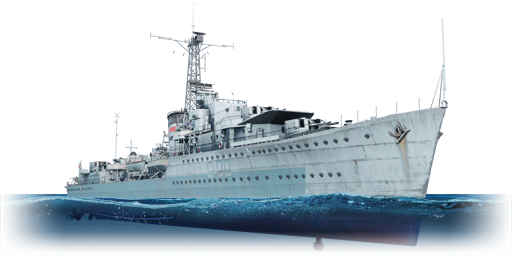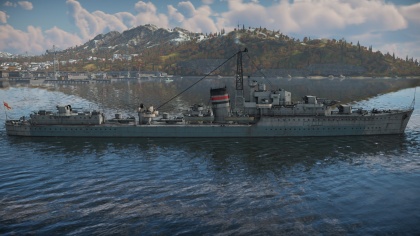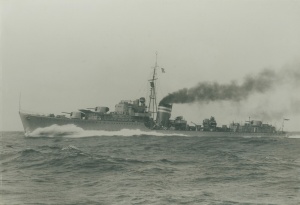HMS Jervis
Contents
Description
The J-class, HMS Jervis (F00), 1944 is a premium rank II British destroyer
with a battle rating of 4.3 (AB/RB/SB). It was introduced in Update "New Power".
General info
Survivability and armour
Talk about the vehicle's armour. Note the most well-defended and most vulnerable zones, e.g. the ammo magazine. Evaluate the composition of components and assemblies responsible for movement and manoeuvrability. Evaluate the survivability of the primary and secondary armaments separately. Don't forget to mention the size of the crew, which plays an important role in fleet mechanics. Save tips on preserving survivability for the "Usage in battles" section. If necessary, use a graphical template to show the most well-protected or most vulnerable points in the armour.
Mobility
Write about the ship's mobility. Evaluate its power and manoeuvrability, rudder rerouting speed, stopping speed at full tilt, with its maximum forward and reverse speed.
| Mobility Characteristics | |||
|---|---|---|---|
| Game Mode | Upgrade Status | Maximum Speed (km/h) | |
| Forward | Reverse | ||
| AB | |||
| Upgraded | 85 | 31 | |
| RB/SB | |||
| Upgraded | 69 | 25 | |
Armament
Primary armament
Provide information about the characteristics of the primary armament. Evaluate their efficacy in battle based on their reload speed, ballistics and the capacity of their shells. Add a link to the main article about the weapon: {{main|Weapon name (calibre)}}. Broadly describe the ammunition available for the primary armament, and provide recommendations on how to use it and which ammunition to choose.
Anti-aircraft armament
An important part of the ship's armament responsible for air defence. Anti-aircraft armament is defined by the weapon chosen with the control Select anti-aircraft weapons. Talk about the ship's anti-air cannons and machine guns, the number of guns and their positions, their effective range, and about their overall effectiveness – including against surface targets. If there are no anti-aircraft armaments, remove this section.
Torpedo armament
Torpedo launchers are standard equipment on many ships and boats. Torpedoes are a significant means of defeating an opponent. Evaluate the position of the torpedo launchers, discuss the ammunition available, firing specifics such as dead zones, features of the torpedoes themselves, etc. If there is no torpedo armament, remove this section.
Usage in battles
Describe the technique of using this ship, the characteristics of her use in a team and tips on strategy. Abstain from writing an entire guide – don't try to provide a single point of view, but give the reader food for thought. Talk about the most dangerous opponents for this vehicle and provide recommendations on fighting them. If necessary, note the specifics of playing with this vehicle in various modes (AB, RB, SB).
Modules
| Tier | Seakeeping | Unsinkability | Firepower | |||
|---|---|---|---|---|---|---|
| I | Dry-Docking | Tool Set | 4.7 inch SAP Mk.VA | 40 mm HE | Anti-Air Armament Targeting | |
| II | Rudder Replacement | Fire Protection System | Smokescreen | 4.7 inch HE-TF Mk.VIIA | 40 mm AP | Auxiliary Armament Targeting |
| III | Propeller Replacement | Shrapnel Protection | Ventilation | Improved Rangefinder | Primary Armament Targeting | |
| IV | Engine Maintenance | New Pumps | Ammo Wetting | 4.7 inch HE-VT Mk.VIIA | Torpedo Mode | |
| This is a premium vehicle: all modifications are unlocked on purchase | ||||||
Pros and cons
Summarise and briefly evaluate the vehicle in terms of its characteristics and combat effectiveness. Mark its pros and cons in the bulleted list. Try not to use more than 6 points for each of the characteristics. Avoid using categorical definitions such as "bad", "good" and the like - use substitutions with softer forms such as "inadequate" and "effective".
Pros:
Cons:
History
HMS Jervis, J-class Flotilla Leader was a destroyer of the J class. Commissioned just before the outbreak of war, Jervis saw extensive service in the Mediterranean and Atlantic theatres. She participated in multiple major engagements in the Mediterranean, and later participated in the D-Day landings of 1944. Jervis was retired at the end of the war, and later scrapped. She was highly decorated and received 13 battle honours for her service in the Second World War. Jervis also gained a reputation for being extremely lucky, as she never lost a single crew member during her 5 and a half years of service.[1][2]
Design and Development
The Jervis, as a member of the J class, was designed as a smaller follow-up to the preceding Tribal-class destroyers. Being smaller, the J class had a stronger balance between guns and torpedo armament, compared to the "gunship-style" Tribal-class destroyers. Jervis, in particular, was fitted with additional command space to accommodate the Flotilla commander. Jervis displaced 2600 tons, and was capable of 36 knots (66 km/h).[1] Her main armament consisted of six 4.7-inch (120 mm) guns in three dual turrets, two mounted at the bow and one at the stern.[1] She also carried numerous anti-aircraft defences as well as eight 533 mm torpedo tubes in two quad-mounts.[1]
Jervis was laid down in mid-1937 and was launched in September of 1938. She was completed and commissioned in May of 1939, just months before the outbreak of the Second World War.
Service history
Following her completion and commissioning, the Jervis served as the flagship of the 7th Destroyer fleet. She first served as a patrol vessel in the North Sea, hunting for axis blockade runners; however, she collided with a freighter in March of 1940 and was dry docked for repairs.[2] Once the repairs were completed, she was assigned to the Mediterranean squadron, where she saw extensive service. She escorted convoys to Malta, participated in shore bombardment missions, and provided screening services to the British Mediterranean fleet.[2]
In 1941, Jervis served in the Battle of Cape Matapan, where she sank the crippled Italian cruiser Zara and boarded Zara's sister ship Pola. She later participated in the battles of Crete and Sirte, where she managed to survive undamaged despite heavy allied losses.[2] Later on, she was immobilized for six weeks by an Italian manned torpedo.[1][2]
In 1944, Jervis was reassigned to the British Atlantic fleet, and provided fire support for the forces landing at Gold Beach for the D-Day landings. She was thereafter decommissioned for a refit which gave her additional anti-aircraft protection.[2] She returned to the Mediterranean after her recommissioning, and served as a patrol ship as World War II drew to a close. Following the end of the war, she was laid up in reserve and used by the cadets as a training ship. After being used for explosive tests, Jervis was given to the shipbreakers for scrap.[2]
Jervis is known as an extremely lucky ship: despite being active for almost the entirety of the war and having served in 13 major naval engagements, she never lost a single crew member.[1] In fact, she was one of just two J-class ships to survive the war. She received 13 battle honours for her service during the Second World War, making her one of the most highly decorated British warships in modern history.[1][2]
Media
Excellent additions to the article would be video guides, screenshots from the game, and photos.
See also
Links to articles on the War Thunder Wiki that you think will be useful for the reader, for example:
- reference to the series of the ship;
- links to approximate analogues of other nations and research trees.
External links
Citations
Bibliography
- D-Day Encyclopedia. (2020). HMS Jervis - F00 - D-Day. Retrieved November 28, 2020, from https://www.dday-overlord.com/en/material/warships/hms-jervis
- Smith, G. (2004). HMS Jervis, Destroyer. Retrieved November 28, 2020, from http://www.naval-history.net/xGM-Chrono-10DD-36J-JervisJERVIS%201a.htm
| Britain destroyers | |
|---|---|
| Town-class | HMS Churchill · HMS Montgomery |
| V-class | HMS Valhalla · HMS Vega · HMS Verdun |
| G-class | HMS Grafton · ORP Garland |
| Hunt-class | HMS Calpe · HMS Brissenden |
| Tribal-class | HMCS Haida · HMS Eskimo · HMS Mohawk |
| J-class | HMS Jervis |
| K-class | HMS Kelvin |
| N-class | HMAS Nepal |
| Battle-class | HMS Armada · HMS Cadiz · HMAS Tobruk |
| Daring-class | HMS Daring · HMS Diamond · HMS Diana |
| Britain premium ships | |
|---|---|
| Motor torpedo boats | MTB-1(2) · MTB-422 · Fairmile D (5001) · HMS Gay Archer |
| Motor gun boats | MGB-75 · SGB Grey Goose |
| Gunboats | HMS Spey |
| Sub-chasers | LÉ Orla |
| Frigates | HMS Whitby |
| Destroyers | HMS Montgomery · HMS Valhalla · HMS Verdun · ORP Garland · HMS Jervis · HMCS Haida · HMS Mohawk · HMS Cadiz · HMS Diamond |
| Light cruisers | HMS Belfast |
| Battleships | HMS Iron Duke |






